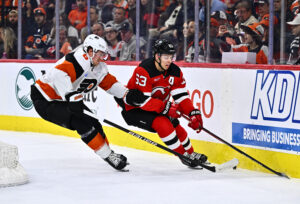The Vancouver Canucks potential moves are going to be influenced this year, more than in any other, by cash. Teams all through the NHL are feeling the hit from the novel coronavirus, and it’s going to show in deals and signings big and small.
Vancouver Canucks Potential Moves
A Book Balancing Act
NHL owners who rely on their teams as a primary source of income have been priced out of the league. Diversified billionaires have replaced millionaires, but that doesn’t mean they are happy to lose money. That very diversity means any cash businesses owned – restaurants or entertainment venues for instance – were hit hard. Once the Stanley Cup Final is finished, that’s it for an unknown amount of time. Games are not going to start again until fans can take part. Bubbles in Toronto and Edmonton happened because the league had to pay off contracts that had already been signed. That pressure doesn’t exist anymore, and the losses of playing in empty arenas simply aren’t worth it.
This doesn’t mean the 2020-21 season won’t happen. It will. But probably not until mid-January 2021. Contracts have to be signed and rosters have to be filled. Prospects have to be placed with teams, wherever they happen to be. In a normal year, around two-thirds of the league is within five million dollars of the salary cap. Some teams stay well away from it because of internal budgets, others because they’re looking to use that space later. This year, however, things are going to be a little different, and likely for at least one more year past that. In an interview with TSN 1040, Darren Dreger said he’s heard that “several” teams who had spent to the cap limit of $81.5 million are aiming well below it this year. At least a few say “the low-70s or lower” is their target.
Wait For It…
The salary cap is going to remain flat next year, and won’t increase at all until hockey-related revenue reaches $3.3 billion over the course of one year. The year after that happens, the cap can go up by one million dollars. When hockey-related revenue hits $4.8 billion, it can go up by $2 million. If everything goes well, in 2023-24 it can increase more, but that’s dependent on what numbers the previous two years produced.
Teams who had been structuring their deals with an increased salary cap in mind suddenly find themselves short. The Vancouver Canucks player moves were clearly made in the expectation of a rising cap. But that pressure is countered by teams deliberately reducing their cash outlay, going below the cap minimum if possible. But even teams who need just temporary relief can target players moving out of cap-tight organizations. Doing that can pick them up not only a premium but a reasonable player as well. Salary retention can reduce the cost even further. Under the current salary cap, a team can retain up to $12,225,000 in total for as many as three players.
Changed Priorities
Jonas Brodin‘s new contract with the Minnesota Wild is a clear example: his six million dollar cap hit is weighted past this year and the next. The cash paid out to him is four million dollars in 2020-21, five in 2021-22 before jumping up. The Pittsburgh Penguins are paying the Wild two million dollars to take Nick Bjugstad, a generally useful but depth forward whose cap hit is twice that. In cash, Bjugstad is owed just over five million, but with the money not paid to Brodin, the team decided they could take that on this year. This will likely be the shape of most multi-year free-agent signings. Younger players might be willing to take a chance with one-year deals, but established veterans want security.
Vancouver’s fans are fortunate in that owner Francesco Aquilini has never hesitated to spend money. The Canucks themselves are very much a moneymaker, and he knows that. While much of his income is from entertainment and travel, going short-term now with one of their bigger cash cows would be a mistake. Not only is he wealthy enough to ride out this downturn, the Canucks may be able to take advantage. This is the year where low-cash deals are at their most valuable to teams. As an added bonus, offering high-cash contracts can bring the most interest from players.
It’s no secret the Canucks are up hard against the cap most years, and this one is no exception. If they want to re-sign their free agents, money is probably going to have to move out. These deals – if they can pull them off at all – will need sweeteners. That can be money or players coming back, younger players/prospects heading out. But part of that sweetener is cash, and Vancouver has low-cash, high-cap contracts to spare.
The Problems
Jay Beagle
Cap hit: $3 million
Cash outlay: $2.2 million (2020-21), $2.2 million (2021-22)
Strange as it sounds to casual fans, Jay Beagle‘s could be the hardest of the Vancouver Canucks potential moves. He’s got a Stanley Cup ring, and the Canucks could retain enough to make him a $1.1 million player. Unfortunately, while he was brought in as a defensive specialist, Vancouver was hoping for more than 13 points in a full season. His defence hasn’t held up, either, though that is partially in his use as well as his ability. For a player who’s going to be 35 years old and has two years left, there’s just not much of value there. He also has a five-team no-trade clause which likely includes teams who might be interested.
Antoine Roussel
Cap hit: $3 million
Cash outlay: $2.5 million (2021), $1.9 million (2021-22)
On the opposite end of the spectrum, Antoine Roussel is the least likely of the “problem contracts” to get moved out. He started his Canucks career with a bang, reaching a career-high in points and bringing speed and agitation to the fourth line. Even in an injury-limited season, he managed seven goals and 13 points in 41 games. He added two goals and four points in 17 playoff games, which is more than Ryan Reaves managed in 19. Roussel also has an eight-team no-trade clause, limiting the possible trade partners.
Brandon Sutter
Cap hit: $4.375 million
Cash outlay: $3.5 million (2021)
Brandon Sutter is a “useful, if” player right now. His solid playoff showing (one goal, six assists all at even strength) highlighted his use in the regular season. He’s a veteran defensive centre who can chip in some points and knows what he’s doing short-handed. At half his price – happy coincidence – he’d be fine. Assuming he could stay healthy, which he managed to do once in his five seasons as a Canuck. On the plus side, he is in the last year of his contract. A team could do worse for a placeholder while a prospect develops.
Loui Eriksson
Cap hit: $6 million
Cash outlay: $1 million (2020-21), $4 million (2021-22)
Ah, the Big One. Loui Eriksson was signed as part of the “Best Free Agent Pool EVAH!!!” frenzy that went on in 2016. You can see for yourself how well that particular statement aged. In any case, he is still an NHL player by virtue of being smart – a trait that hasn’t deteriorated with his scoring. The Canucks can retain $2 million for the next two years, though they might not want to after paying out $3 million in a signing bonus July 1st. And don’t get us wrong: any team getting Eriksson will be doing the Canucks a favour and will have to be compensated accordingly. But the bump in cap space with a limited cash outlay can help teams in a specific situation. That Eriksson is modestly useful in a fourth-line/penalty kill role isn’t even part of the conversation.
The Bait
Brock Boeser
Cap hit: $5.875 million
Cash outlay: $3.125 million 2020-21, $7.5 million 2021-22
If a team wants Brock Boeser, they’re going to have to pay. His rock-bottom cash price this season changes dramatically next year, just in time for a sky-high qualifying offer. Boeser’s injury history can keep teams from making him the anchor of their offence, and reasonably enough. But he has improved his passing and puck retrieval skills as well, making him dangerous on any line. Boeser isn’t going to be a toss-in on any deal. If he leaves town, they’ll need to get something for him.
Jake Virtanen
Cap hit: unknown
Cash outlay: unknown
You’d think re-signing a free agent who scored 18 goals in 69 games and made just $1.25 million the year before would be a no-brainer. And the 24-year old Jake Virtanen is obviously tempting to teams for just those reasons and more. He’s fast, young, cheap, hard-hitting… and ultimately frustrating. He followed a very good regular season with a disappointing playoff, so where his arbitration hearing is going is anyone’s guess. If he’s one of the Canucks player moves, there will be some blowback from disgruntled fans, but it may just be time.
Thatcher Demko
Cap hit: $1.05 million
Cash outlay: $1.2 million
What Thatcher Demko could bring back in trade is debatable. He has just 37 regular-season NHL games under his belt, with a mere .906 save percentage and 3.02 goals-against average. He was improving in the ten-game stretch he ended the season with, but it was nothing earth-shattering. For that, we’d have to wait for the playoffs. With two goals allowed on 130 shots against over four games, he was blamed for the Vegas Golden Knights’ loss in the NEXT round. Wherever he is for 2020-21, that team is going to have a veteran as well, one that is probably also on a one-year deal. Of all the Canucks player moves, this is the one that carries the highest risk. Is Demko a flash in the pan, the real thing, or somewhere in-between? They – or someone else – will have one year at a paltry $1.2 million to find out.
The Bottom Bottom Line
Any of these players could go, for better or worse, and not always for hockey-related reasons. Whether that’s a blessing or a curse is going to be discovered well after the deals are done. But given GM Jim Benning‘s track record, we get the feeling more fans are going to forgive him if the Vancouver Canucks potential moves are trades than free-agent signings.
Main Photo:
Embed from Getty Images






